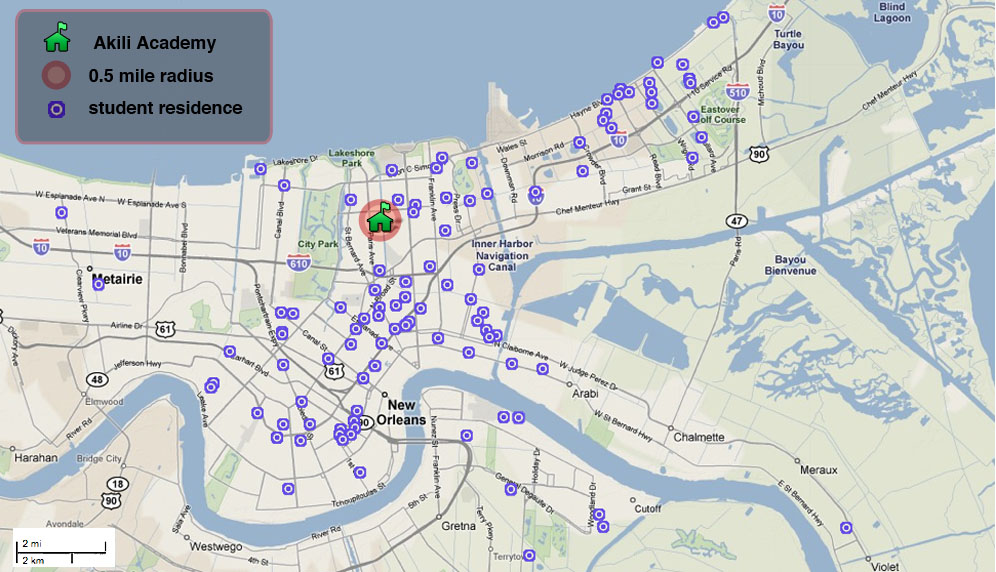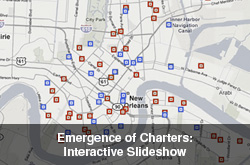Rebuilding Communities From the School Up
Kai Carter | Jul 27, 2009 | Comments 2
By Kai Carter
with reporting by Meghan Berry and Alexandra Fenwick and media production by Dana Chivvis
The Cost of Choice
It’s 5:35 a.m. Five-year-old Desmond Morrison waits with his mother for his school bus at the intersection of Lake Forest Boulevard and Bundy Road. The kindergartener’s journey — or his “roller coaster,” as he calls it — takes him all around New Orleans East, onto Interstates 10 and 610, reaching Akili Academy charter school by 7 a.m.
Desmond is one of the many New Orleans students who now travel long distances to school, some with nearly two-hour commutes. Since Katrina, more than half of the city’s traditional public schools have remained closed, leaving many families without a school option in their neighborhood. With the emergence of 49 charters between 2005 and 2009, New Orleans became an “open-choice” district where students attend their school of choice, regardless of place of residence.
Choice, however, comes with a steep price. The Times Picayune estimates that public schools spent $6 million more this past year in transportation costs than it did four years ago, even though 30,000 fewer children were enrolled. Akili Academy alone spent about $168,000 last year to transport around 90 of its 120 students — a large chunk of its budget that could have been used in the classroom if its student body lived within walking distance. Currently, no Akili students walk to school.
-
 According to Louisiana’s Recovery School District, public elementary schools should ideally serve students within a half mile radius. No Akili students live within this parameter. The farthest lives 18.8 miles away. Source: Akili Academy
According to Louisiana’s Recovery School District, public elementary schools should ideally serve students within a half mile radius. No Akili students live within this parameter. The farthest lives 18.8 miles away. Source: Akili Academy
Filed Under: Featured • New Orleans in Depth
About the Author: Carter is a master in public policy candidate at the Harvard Kennedy School of Government where she also is a senior editor for the Harvard Journal of African American Public Policy. She is specifically interested in how policy impacts minority and underserved populations. Originally from Los Angeles, Carter graduated from Brown University with a bachelor’s in international relations. In 2007, she secured a Rotary Ambassadorial Scholarship for studies at the University of the South Pacific and interned at the United Nations Development Program in Fiji. After, Carter worked at the Woodrow Wilson International Center for Scholars in Washington.














It’s not acceptable that children can’t walk to school anymore. How are we supposed to rebuild our communities without having schools that children can walk to?
Miss Carter’s article is very interesting. It points out the ineffective use of the students’ time and the school district’s money. We diminish learning when children have such long commutes. There must be a better solution. Hopefully, the writer and her generation will do a better job with public policy than we have.